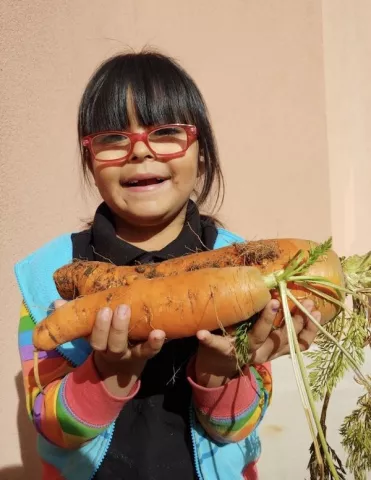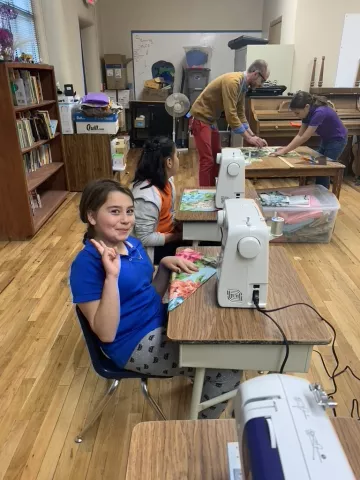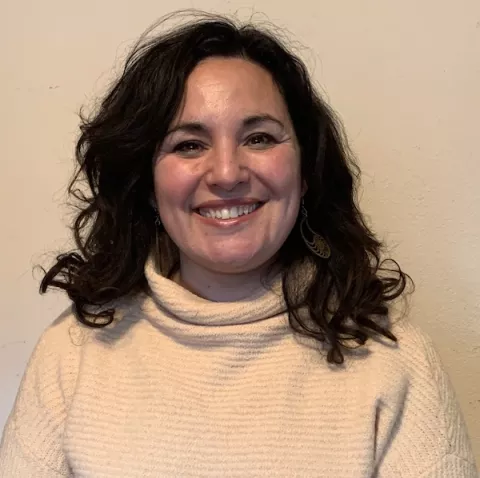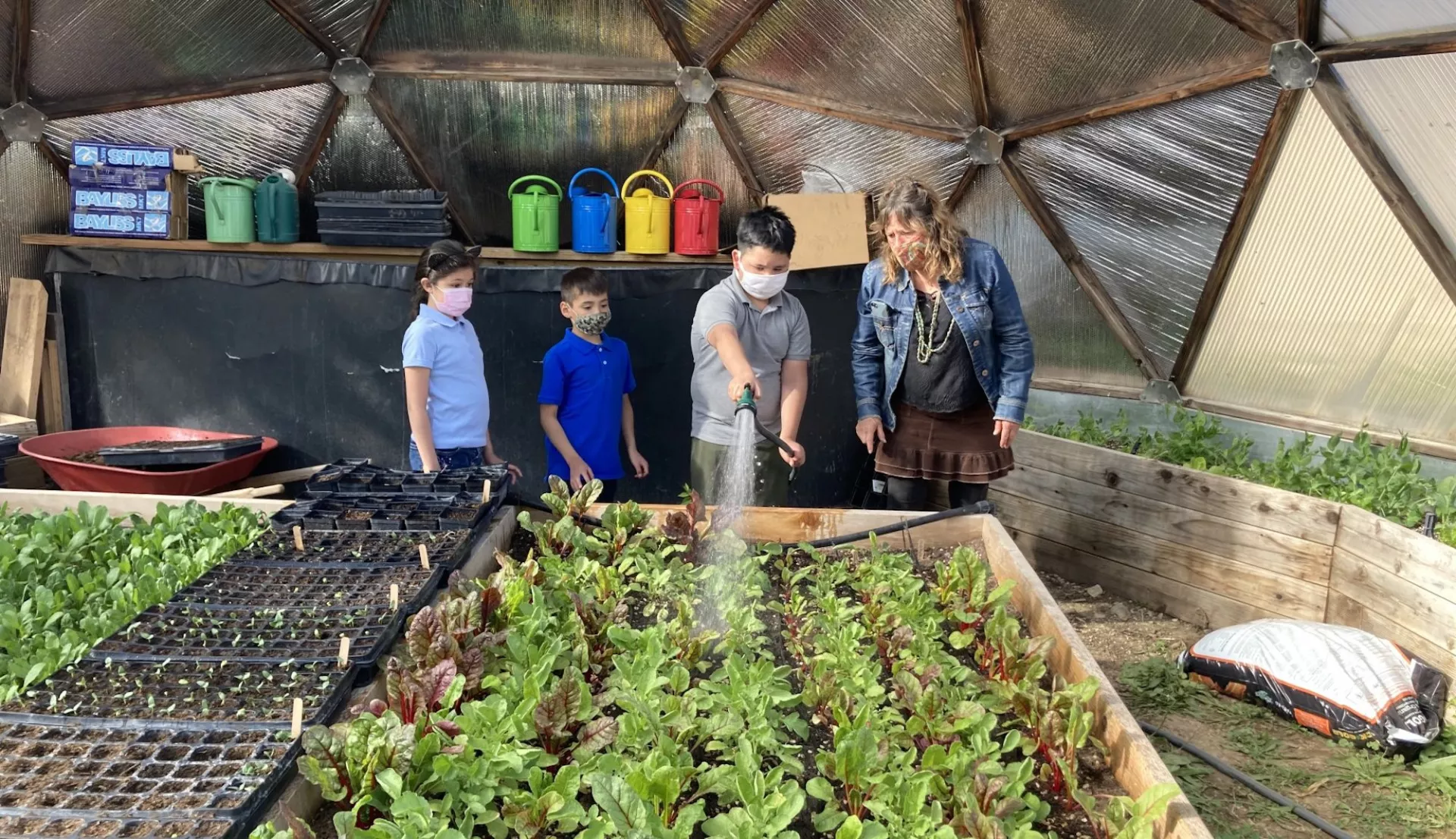Key Takeaways
- The Department of Education announced $63 million in new five-year Full-Service Community Schools (FSCS) grants to support 42 districts.
- A bipartisan funding bill also doubled the amount of community schools funding, from $75 million for 2022 to $150 million in 2023
- Taos Municipal School District in New Mexico is one of 42 in the nation to receive federal grant money.
Querencia, a Spanish word that means the love of one’s home and one’s land, is at the heart of Northern New Mexico culture. It’s also at the heart of Enos Garcia Elementary School in Taos, New Mexico, a community school that will be expanded after its district won a new federal grant.
“Gardening and cooking are part of our after school program offerings,” says Enos Garcia Community School Coordinator Paula Oxoby-Hayett. “Food and gardening and working the land is part of the culture in our region, and at Enos Garcia, we have a greenhouse and garden that’s embedded into our students’ lives – they bring food home that they harvest, it’s used in the school cafeteria, or in their cooking classes. It brings us all together.”
New community school funding from the Department of Education, will bring the entire district together under the community schools umbrella providing structures for exciting partnerships with organizations such as Growing Community Now, a farm to school program that includes gardening and cooking classes for students that helps them learn about local ecology as well as healthy nutrition.
NEA-Backed Community Schools Model Receives Historic Funding
On January 18, the Department of Education announced $63 million in new five-year Full-Service Community Schools (FSCS) grants to support 42 local educational agencies, non-profits, and other organizations working to expand existing community schools or establish new programs in eight new states and territories, including Alabama, Alaska, Louisiana, Maryland, New Mexico, Oklahoma, Tennessee and Puerto Rico.
In December, a bipartisan funding bill also doubled the amount of community schools funding, from $75 million for 2022 to $150 million in 2023.

“After NEA passed a national policy statement on community schools in 2018 and launched the NEA Community Schools Institute, we’ve seen funding for community schools grow from $17.5 million in 2018 and 2019, to $25 and $30 million in 2020 and 2021, to the historic highs of $75 million last year and $150 million this year,” says Kyle Serrette, NEA Community Schools policy analyst. “In addition to this funding spike, districts in the NEA Community Schools Institute are recipients of five-year federal grants, including Taos and Las Cruces in New Mexico and Austin, Texas.”
To Oxoby-Hayett and her community school partners in the Taos Municipals School District, the increased funding means “that people believe in the work we do every day, and the potential it holds for students, families and communities to work together and thrive.”
In practice, the increased funding means an opportunity to implement the community school strategy in all Taos public schools to ensure equity and access for the students that need it most.
“As we are still facing the aftermath of the COVID pandemic, the demands on the schools keep growing,” Oxoby-Hayett says. “The funding means that each school will have a community school coordinator to lead the strategy and a district coordinator to ensure alignment between schools and supports for the coordinators are in place.”
Now, all the Taos schools can implement programs similar to those she has worked to build at Enos Garcia over the past four years.
Removing Barriers to Learning
In 2019, the New Mexico Legislature enacted House Bill 589, the Community Schools Act, which defined a community school as "a public school that partners with families and the community, including tribal partners, nonprofit community-based organizations and local businesses, to provide well-rounded educational opportunities and supports for student success through the implementation of a community school framework." The legislation also created a funding stream to kick start community schools, like the one at Enos Garcia Elementary.
In 2019, Enos Garcia Elementary was awarded a Community Schools Planning grant from New Mexico Public Education Department. In 2020, the school secured additional state funding for three more years to implement the community schools model, becoming the first community school among the public schools in the district.

“Our goal is to remove barriers to learning, and the first thing we did, after hearing that it was the top priority of parents and the community, was to start an after school program for tutoring, homework help and enrichment activities,” Oxoby-Hayett says. “That was identified every year of our parent survey as the top priority, so we continue to deliver on that.”
Beyond that, the school partners with community organizations to offer programs families couldn’t otherwise access or afford, like a sewing class, soccer, gardening, dance and art classes at the Harwood Museum of Art, within walking distance from the school.
“Both boys and girls love the sewing class, and though we may not have the next Coco Chanel coming out of our program, the kids learn to make or mend clothes, and we’re thrilled by that,” Oxoby-Hayett says. “As a community school, we give them exposure to activities that impacts learning and is also a lot of fun -- they learn new skills and develop new passions, like all children should be able to do.”
Everything that happens at a community school like Enos Garcia is designed to keep students and families as stable as possible.
For example, they help support families with their bills like rent and utilities.
“If students are cold, and there’s no electricity, they can’t be well, let alone do homework or learn,” Oxoby-Hayett says.
At a Community School, Educators Ask and Listen
Community schools help students and families by creating spaces where educators can listen. They never assume anything. They know what families need because they ask and hear firsthand what is important to them.
Like everywhere, the community’s mental health was impacted by COVID. But the mental health of students was identified as a priority even before the pandemic, so the school provides a nurturing center where students who may have had a disagreement with a classmate or a bad night at home can relax in a bean bag chair, talk to someone, or just play with sand while they collect themselves and their emotions.
There are onsite mental health services provided through a school collaboration with Taos Behavioral Health and its partner agencies. It’s on site, so parents don’t have to worry about scheduling or transportation.
“We also have SEL programs for students every other week with activities where they learn how to express what their feeling,” she says. “We’ve learned that these kids have experienced tremendous loss. Some lost loved ones to COVID, some have parents in jail, others’ parents are just gone from their lives. SEL programs help, and we can also refer them to the mental health service providers through the school.”
They also offer help to families, such as obtaining legal rights for grandparents, offering grandparent support groups, and a Spanish language liaison.
By partnering with community organizations like Taos Behavioral Health, the Taos Community Foundation, the DreamTree Project, AmeriCorps, the Food Depot and Growing Community Now, Enos Garcia meets their students’ and family’s basic needs.
Connecting Through Food and Culture
A quarter of Taos County students face food insecurity, reports Taos News, and by leveraging nearly $300,000 worth of community-provided support and services over the past four years, and by distributing $11,000 worth of donated items like food, clothing and school supplies, as well as $10,000 in monetary donations, Enos Garcia has removed obstacles to learning in students' lives.

With the new grant funding, Taos can now remove those obstacles for all students, district-wide.
“One feature we are really excited about is our collaboration with Grow Community Now,” says Oxoby-Hayett.
This community-based program will bridge all five schools and involve local partners to ensure food security for families, increased access to local food sources, student connections to traditional and cultural agricultural practices of the region, and continuum of K-12 food learning programs and opportunities for postsecondary career pathways in areas like agriculture, gardening, or culinary arts.
“The ages of students and needs of families at our schools are different, but the love of local food, the land and culture connects us all,” she says.
And that is querencia in action.


